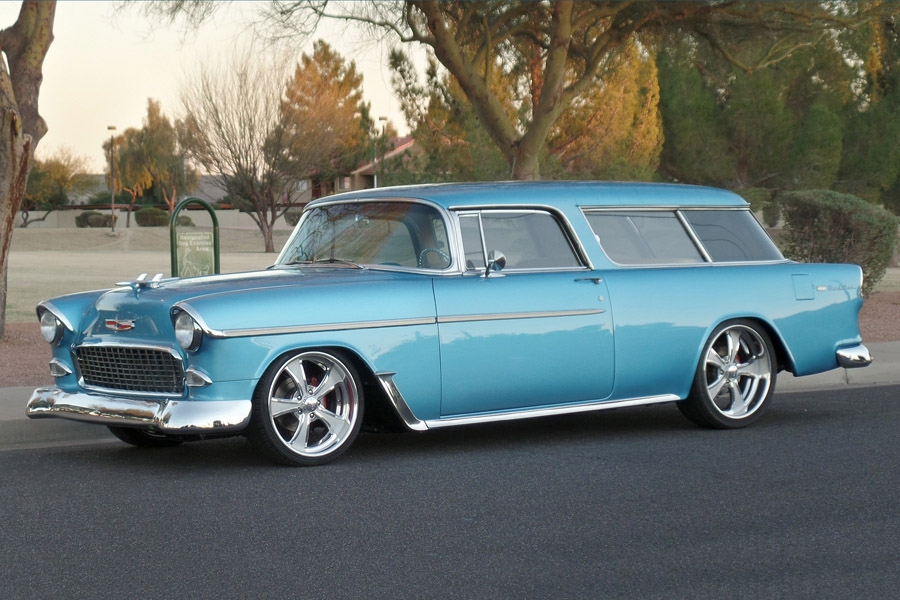SCM Analysis
Detailing
| Vehicle: | 1955 Chevrolet Nomad Custom Wagon |
| Years Produced: | 1955–57 |
| Number Produced: | 23,167 |
| Original List Price: | $2,571 |
| SCM Valuation: | Median to date, $70,000; high sale, $220,000 |
| Tune Up Cost: | $200 |
| Distributor Caps: | $13.95 |
| Chassis Number Location: | Left front door-hinge pillar |
| Engine Number Location: | Pad on front right hand side of the block behind the water pump |
| Club Info: | Chevrolet Nomad Association |
| Website: | www.chevynomadclub.com |
| Alternatives: | 1955–57 Pontiac Safari wagon, 1953–55 Chevrolet Corvette, 1955–57 Ford Thunderbird |
| Investment Grade: | B |
This car, Lot 454, sold for $95,700, including buyer’s premium, at Barrett-Jackson’s auction in Palm Beach, FL, on April 9, 2016.
The 1955 Chevrolets were a dramatic departure from the Chevys of the past, and the most dramatic was the stunning Nomad wagon. From the end of World War II, the station wagon had been transformed from an expensive wood-bodied luxury hauler to an affordable all-steel family transporter. But the Nomad took that utility to a whole new level.
A star from the start
Like the Corvette the year before, the Nomad was the star of the 1954 New York Auto Show, with a display in the lobby of the Waldorf Astoria hotel. The Motorama dream machine was based on the Corvette, but the final product was built on the Bel Air platform.
When it became a part of the all-new Chevrolet lineup for ’55, the Nomad carried the same front sheet metal as the rest of the “Hot Ones.” That distinctive grille and clean design by stylist Carl Renner was said to have been inspired by Ferrari. From the doors back, however, the Nomad was completely unique. The B-pillar leaned forward like nothing before it, and the rear C-pillar and hatch followed suit.
Two is more
Two-door wagons were hardly unique at the time, but most manufacturers often relegated them to economy, business coupe or panel-truck status. Not the Nomad. Offered only on the top-shelf Bel Air line, the Nomad was a practical dream car come true. Pontiac shared the Nomad’s body, but the Safari’s longer wheelbase and Pontiac’s “Silver Streak” styling couldn’t match the Nomad’s unique character.
The Nomad may also have been the solution to a need that didn’t exist. It was the most expensive car in the ’55 Chevrolet line (only the Corvette cost more), and just 8,530 were built that year, with an additional 8,103 in ’56. The ever-popular 1957 Nomad, the last year for the model, was almost outsold by the resurgent Corvette, with just 6,534 built. Universally hailed as a design tour de force, the Nomad was too expensive, and maybe deemed too impractical, for the average meat-and-potatoes Chevrolet buyer.
It wasn’t until a decade later that the Nomad seemed to find its niche. Maybe it was the fun-in-the-sun Southern California culture, with the image of a surfboard hanging out of a Nomad’s hatch. Or maybe it was the Kalifornia Kustom culture running with the surf image. Whatever the reason, since the ’60s, the Nomad has held its ground as one of the most popular cars of its era.
Preserve or rod?
Nomads divide owners into two camps: the traditionalist who restores his car to historic perfection, and the customizer who molds his into a personal dream car. You could say that about almost any American car from the past, but the 1955–57 Nomads stand out as some of the most favored platforms for restoration or individualization.
Anyone who has driven a factory-stock vehicle from the ’50s in today’s traffic really can’t blame someone for bringing a Nomad’s suspension, brakes and powertrain into the present. Upgrading the interior and adding air conditioning and modern sound makes sense, too.
Under normal circumstances, modifying a vehicle can easily have the effect of killing its resale. The rule of thumb for customized cars is simple — don’t expect to get your money back out of it. And the reason is just as simple: No one wants to buy someone else’s dream car; they want to build their own.
Taste is subjective, and chances are that one person’s vision of automotive perfection — stock-looking “rectification,” the Pro-Mod look, a lead sled, you name it — is different from the next person’s. It’s often hard to find a buyer with the same taste. However, there are always exceptions, and Nomads are one of those exceptions.
We’ve seen custom Nomads sell for as much as $324,000 (ACC# 36961), but I couldn’t find a stock Nomad higher than $110,000 (ACC# 48725), and that was an exceptional restoration.
Our featured Nomad didn’t quite merit six figures, but it’s a very nice dream wagon just the same. It has all the suspension, engine and comfort upgrades a modern driver would want, and on top of that, it has a great look, too. Clearly, the owner of 22 years lavished the Nomad with TLC, and if much of the work was done years ago, he might have netted some profit from the sale.
The buyer got a tastefully done custom at the cost of doing it today, or even a bit less. Maybe by changing a few items the new owner will have a Nomad that checks all his dream-car boxes, and at a very good price. Call this one both well bought and well sold.
(Introductory description courtesy of Barrett-Jackson.)
